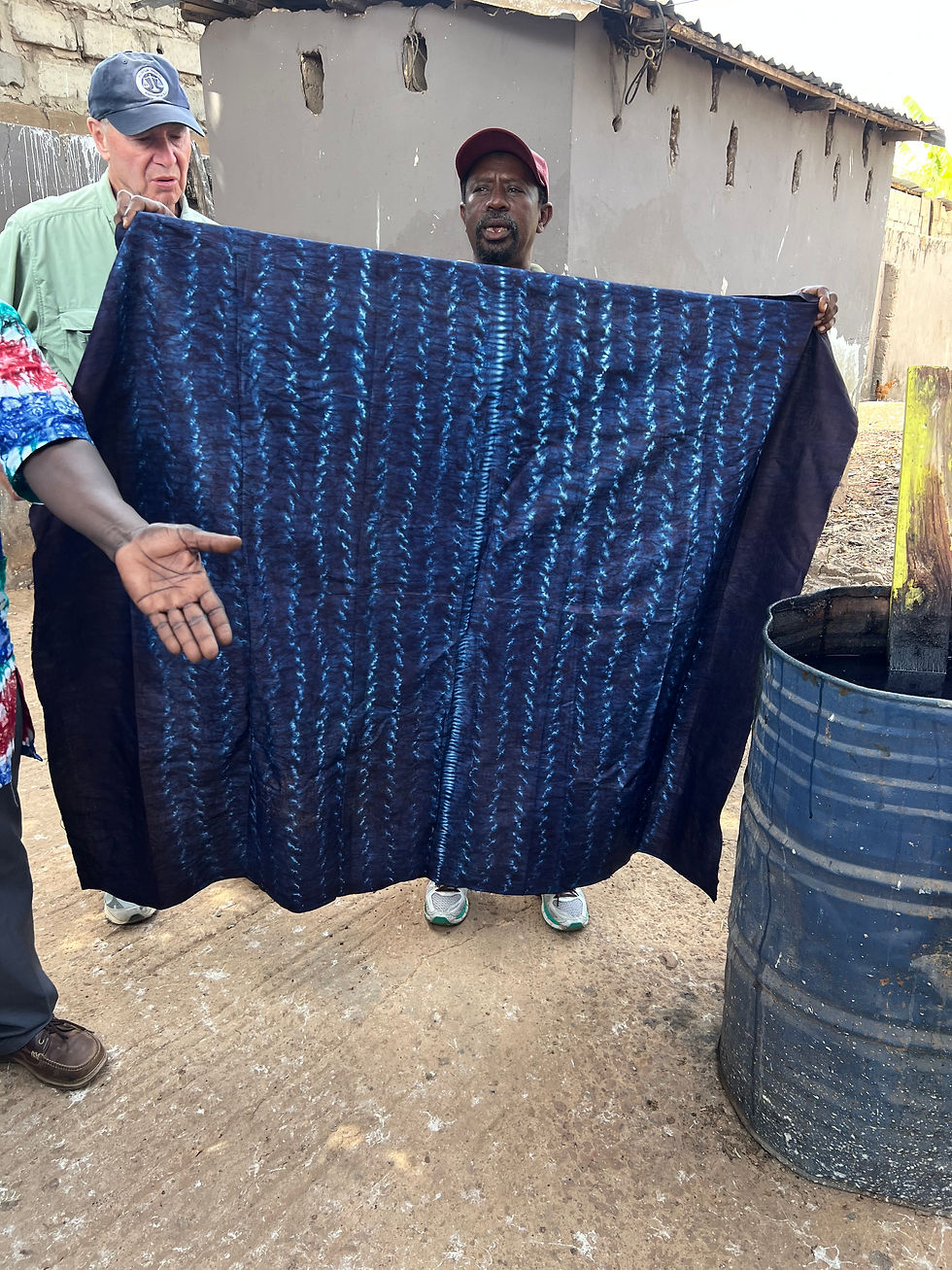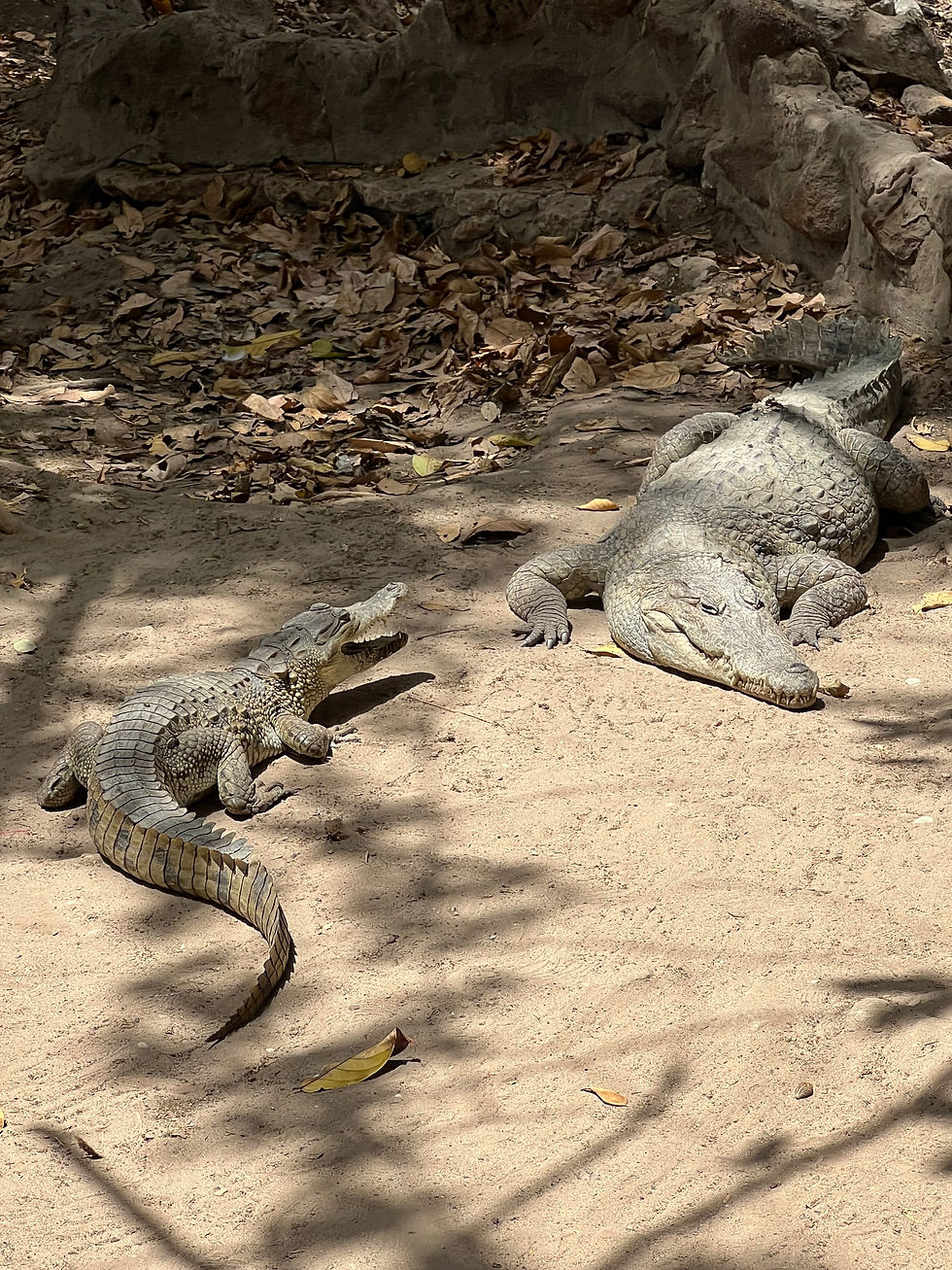Day 64, Banjul, The Gambia
- nansknits19
- Mar 26, 2023
- 5 min read
Nothing like being greeted by a brass band as we stepped off the ship.

Banjul, capital city of The Gambia is the nation's fourth largest city located on St Mary's Island where the Gambia River meets the Atlantic. Banjul takes its name from the Mandinka language and means rope fiber, once their primary export. Initially a German settlement, it was ceded to the British in 1816 who took steps to suppress the slave trade. Now something of an African melting pot, one can still see and hear the British influence.
Many months ago when planning excursions along our route, I was very excited about one in particular: "Roots Juffureh River Cruise" or perhaps more clearly, the retracing of Alex Haley's roots including a visit with the village chief and Kunta Kinteh family. Wow! Sign me up! Imagine my disappointment when only a few days prior to our arrival, the excursion was cancelled due to "technical issues". Always willing to assist, the Destinations Desk was able to find another excursion for me, "Banjul Highlights". Ho Hum, when all else fails, let's do a highlights tour of wherever. My interest increased exponentially as soon as I saw the highlights included a tour of a batik factory. Okay! Let's get going!
First on the agenda was a stop at a museum which we probably did but I cannot recall anything about a museum nor do I have any pictures of same. I do remember seemingly endless blocks of markets, people, carts and cars in the streets, oblivious to our desire to pass through the city. Somewhere in that jumble was the jewelry shop (closed) where we were to have stopped. Oh well, no place to park anyway. Our guide, a retired university professor, explained that it was especially crowded on this day due to the fast approaching start of Ramadan. He also enlightened us on the official name of his country, The Gambia. Seems it was necessary to add "The" to set Gambia apart from Zambia. Shipments were being misdirected and all kinds of other inconveniences occurring. Solution: add "The", problem solved.
My travels in Africa thus far remind me of a bumper sticker I saw years ago in Georgetown, Texas which said, "If You Are In Such A Hurry, Why Are You In Georgetown?" I shall try to adopt that Georgetown philosophy for the remainder of this trip. Life will be so much simpler.
Eureka! We arrive at the batik "factory" which is really a very large courtyard containing dozens of large tables piled high with batik. If you wanted batik of any shape form or fashion, they had it. Our professor guide had instructed us that the name of the game here was bargaining - never were we to accept the first price. When given a price, we should counter with what we would pay. (Little did he know that that WAS the Newman way on everything, everywhere. He was the champion.) What he didn't tell us was that one very elderly woman sitting amongst the tables of merchandise had the final say, not the person with whom we were bargaining. Only if she approved was it a done deal.


The making of batik explained and demonstrated.

The vat contained indigo dye made with chemicals and palm leaves, I think.

According to the friendly gentleman holding the cloth, this particular color fabric is used as the bride's headdress during the wedding ceremony, symbolizing much the same thing as our white wedding gowns. If only he had a bride, he could demonstrate.

Rest assured, I did purchase a beautiful piece of batik, just not my bridal headdress.
After the batik factory, we were treated to refreshments at an impressive luxury hotel overlooking the Atlantic. The walls and common areas were filled with expensive African art.


One of several statues adorning the pool area.

Views of the Atlantic Ocean from the pool patio where we were served refreshments.


More of their beautiful artwork.

Very nice school building with partially enclosed playground with grass! An unusual sight here as most space is taken up with markets, houses, streets, vegetable gardens, very narrow sidewalks and commercial buildings. Little space left over for grass. In The Gambia everyone must attend school, even the herd of goats (below) that roamed all over town. Twenty or so goats of all ages went everywhere we did.

In order to get to the crocodile pool, it was necessary to transfer to smaller buses. Being ever so enterprising, what better place to make the transfers necessitating some wait time than a market across from the school. Many of our group participated in some serious retail therapy to the extent that I'm wondering how they are going to get all their purchases home. Not my problem. I did appreciate the very pretty young policewoman who accompanied us throughout the day. Thankfully her services were not needed but she was there just in case.

Now my turn on the shuttle to the crocodile pool and museum. True to its sign, there was a pool in which I actually spotted three crocodiles swimming. Otherwise they were basically free range crocodiles. Guests were encouraged to stay on the walkway unless given specific permission to pet the creatures, but apparently the crocodiles had no such restriction as one crawled/scurried/walked/waddled (you pick the verb) over to the sidewalk and relieved himself there in the middle of our allotted space. Caused quite a stir I must say. According to the caretaker of the crocodiles, approximately 100 live in this preserve, average live of which is between 100 and 125 years. Now who has the job of tracking that? Is there a crocodile birth record kept somewhere and if so how on earth do they tell one from another? Do they have rings like trees? After a bit, the crocodile keeper invited us one at a time, approaching from the back, to pet the crocodiles. Some did, others did not. At first I said, "No Way! Not Me!" Then it occurred to me that the purpose of this trip is to see and experience as much as I possibly can while I still can. Where else am I going to have the chance to pet a crocodile? So pet the crocodile I did.


Their caretaker explained that it is safe to pet these crocodiles because they are only fed fish, thus do not know the smell of blood or taste of meat. Oh and by the way, feel free to contribute to the cost of their 250 pounds of fish a day. The stroll around the grounds proved that their were many more scattered all over the place if you looked closely. In the museum everything was written in a language other than English so I was unable to gain any knowledge there, but I did enjoy watching three guys sitting out in the courtyard. One carving a statue, the other two playing music. Once everyone who wanted to do so had had their turn petting the crocodiles, we returned to our shuttle, back to the market and bus, then back to the ship. A perfectly delightful day ended with dinner at Toscana's with three couples whom I had not previously met.
Today Is Someday! Pet the Crocodile! (If he's drugged as I suspect these were.)



Comments